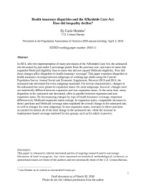
An official website of the United States government
Here’s how you know
Official websites use .gov
A .gov website belongs to an official government organization in the United States.
Secure .gov websites use HTTPS
A lock (
) or https:// means you’ve safely connected to the .gov website. Share sensitive information only on official, secure websites.
-
//
- Census.gov /
- Library /
- Census Working Papers /
- Health insurance disparities and the Affordable Care Act
Health insurance disparities and the Affordable Care Act: How did inequality decline?
Health insurance disparities and the Affordable Care Act: How did inequality decline?
Introduction
In 2014, after the implementation of many provisions of the Affordable Care Act, the uninsured rate decreased by just under 3 percentage points from the previous year, and more in states that expanded Medicaid eligibility than in states that did not expand Medicaid eligibility. How did these changes affect disparities in health insurance coverage? This paper examines disparities in health insurance coverage between subgroups of working-age adults using the Current Population Survey Annual Social and Economic Supplement. Between 2013 and 2014, the uninsured rate decreased for every subgroup examined. For several characteristics, changes in the uninsured rate were greater in expansion states; for most subgroups, however, changes were not statistically different between expansion and non-expansion states. At the same time, many disparities in the uninsured rate decreased, often in parallel between expansion and non-expansion states. By decomposing changes by type of health insurance coverage, important differences by Medicaid expansion status emerge. In expansion states, comparable increases in direct-purchase and Medicaid coverage rates explained the overall change in the uninsured rate, as well as changes for most subgroups. In non-expansion states, increases in direct-purchase accounted for almost all of the total change in the uninsured rate, while the increase in employment-based coverage mattered for key groups, such as for adults in poverty.
Others in Series
Families and Living Arrangements
Working Paper
Working Paper
Share
Related Information
RESEARCH MATTERS BLOG
Health Insurance Disparities are Closing Among Working-Age AdultsSome content on this site is available in several different electronic formats. Some of the files may require a plug-in or additional software to view.
 Yes
Yes
 No
NoComments or suggestions?


Top


